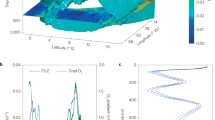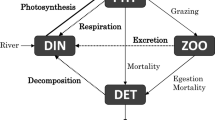Abstract
Instances of strong oxygen variations are described for two shallow water stations in the Kattegat, situated at the fluctuating frontal zone between outflowing surface water from the Baltic and inflowing bottom water from the Skagerrak/North Sea.
The events consist of both a rapid emergence and a rapid disappearance of oxygen-depletion. Changes in oxygen concentration amounted to more than 20 g m−2 d−1 for the total water columns. Such high rates of change can not be explained by net local bottom oxygen consumption (0.6 g m−2 d−1) or net local water oxygen consumption (1.6 g m−2 d−1). The oxygen variations were influenced by the local and regional meteorological conditions. The observed instance of shallow water oxygen-depletion was connected to upward movement of the pycnocline and associated advective transport of oxygen-depleted Kattegat bottom waters to a shallow water area. Similarly, rapid disappearance of the bottom water oxygen deficit in a shallow water area was found to depend more on pycnocline lowering in connection with advective transport, than on the effect of local wind driven mixing.
Similar content being viewed by others
References
Jacobsen, T. S. & N. E. Ottesen Hansen, 1985. Oxygen Depletion in the Kattegat., Nordic Hydrology 16: 237–256.
Jensen, T. G. & G. Kullenberg, 1981. On the efficiency of the wind to generate vertical mixing. Geophysica 17: 47–61.
Kullenberg, G., 1981. Physical Oceanography. In: Voipio, A. (ed.): The Baltic Sea. New York, 418 pp.
Schrøder, H. & J. S. Møller, 1986. Mechanisms responsible for oxygen conditions in the deep water of the Kattegat and the Belt Sea. 15th conf. of the Baltic Oceanographers: 561–581.
Schwærter, S., C. Christiansen, P. Andersen & J. S. Laursen, 1990. Importeret iltsvind i Vejle Fjord. Faglig rapport fra DMU, nr. 4, 279–282 (in Danish).
Sehested, I. H., G. Ærtebjerg, L. A. Jørgensen & F. Bo Pedersen, 1990. Analyse of iltsænkningen i Kattegat, Bælthavet og V. Östersø. The National Agency of Environmental Protection, Denmark, Nr. 1, 133 pp (in Danish).
Simpson, J. H., J. Brown, J. Matthews & E. Allen, 1990. Tidal straining, density currents, and stirring in the control of Estuarine stratification. Estuaries 13: 125–132
Skyum, P. & L. C. Lund-Hansen, 1992. Barotropic and Baroclinic forcing of a semi-enclosed bay., Geogr. Annlr. nr. 4, 74: 363–373.
Stigebrandt, A., 1983. A model for the exchange of water and salt between the Baltic and the Skagerrak. J. Phys. Ocean. 13: 411–427.
Stigebrandt, A., 1991. Computations of oxygen fluxes through the sea surface and The net production of organic matter with application to the Baltic Sea and adjacent Seas., Limnol. Oceanogr. 36: 444–454.
The Belt Project, 1981. Evaluation of the physical, chemical and biological measurements. The National Agency of Environmental Protection, Denmark, 81 pp.
UNESCO, 1981. Unesco technical papers in marine science. No. 38.
Author information
Authors and Affiliations
Rights and permissions
About this article
Cite this article
Skyum, P., Christiansen, C., Lund-Hansen, L.C. et al. Advection-induced oxygen variability in the North Sea-Baltic Sea transition. Hydrobiologia 281, 65–77 (1994). https://doi.org/10.1007/BF00006436
Received:
Revised:
Accepted:
Issue Date:
DOI: https://doi.org/10.1007/BF00006436




